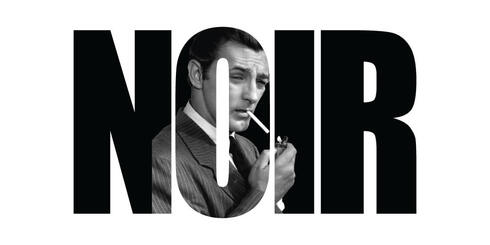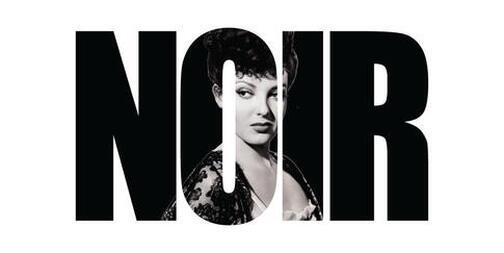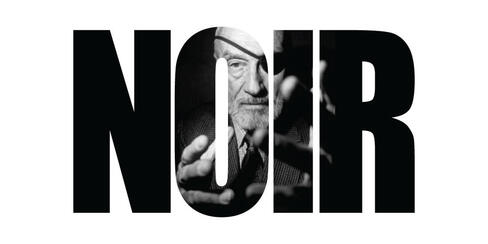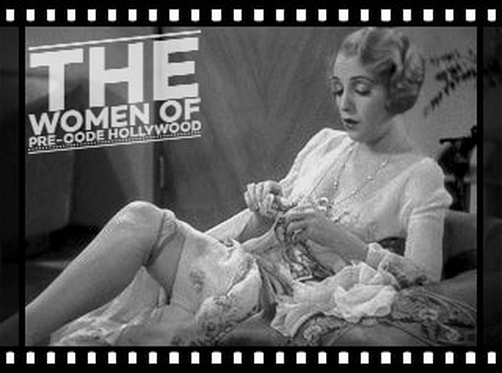JANE GREER
AND FILM NOIR
Jane Greer made significant contributions to the film noir genre through her portrayal of femme fatale characters and her ability to embody the dark and mysterious qualities associated with the genre.
Greer's most iconic role in film noir was as Kathie Moffat in "Out of the Past" (1947). Her performance as a seductive and treacherous woman caught in a web of deceit alongside Robert Mitchum's character is considered one of the quintessential femme fatale portrayals in film history. Greer's nuanced performance captured the essence of the femme fatale archetype, combining allure, cunning, and a sense of danger. Her chemistry with Mitchum and her ability to convey complex emotions and motivations added depth to her character and elevated the film to classic status.
In addition to "Out of the Past," Greer appeared in several other notable film noirs, often playing enigmatic and morally ambiguous women. In "They Won't Believe Me" (1947), she portrayed a seductive woman caught in a love triangle with Robert Young and Susan Hayward's characters. Her performance in this film showcased her ability to convey a sense of mystery and ambiguity, leaving audiences uncertain of her true intentions.
Greer also starred in "The Big Steal" (1949), a film noir with a touch of comedy, where she played opposite Robert Mitchum once again. Her portrayal of a woman entangled in a convoluted plot of deception added an extra layer of intrigue to the film.
Greer's performances in film noir were characterized by her ability to captivate audiences with her beauty, sensuality, and enigmatic allure. She brought a complexity and depth to her femme fatale roles, blurring the lines between victim and perpetrator, and challenging traditional gender roles of the time. Her contributions helped shape the femme fatale archetype and contributed to the overall atmosphere of suspense, intrigue, and moral ambiguity that define the film noir genre.
While Greer's filmography extends beyond film noir, it is her work in the genre that remains her most enduring and celebrated contribution to cinema. Her performances continue to be studied and appreciated by film enthusiasts and serve as a testament to her talent and impact within the realm of film noir.
Greer's most iconic role in film noir was as Kathie Moffat in "Out of the Past" (1947). Her performance as a seductive and treacherous woman caught in a web of deceit alongside Robert Mitchum's character is considered one of the quintessential femme fatale portrayals in film history. Greer's nuanced performance captured the essence of the femme fatale archetype, combining allure, cunning, and a sense of danger. Her chemistry with Mitchum and her ability to convey complex emotions and motivations added depth to her character and elevated the film to classic status.
In addition to "Out of the Past," Greer appeared in several other notable film noirs, often playing enigmatic and morally ambiguous women. In "They Won't Believe Me" (1947), she portrayed a seductive woman caught in a love triangle with Robert Young and Susan Hayward's characters. Her performance in this film showcased her ability to convey a sense of mystery and ambiguity, leaving audiences uncertain of her true intentions.
Greer also starred in "The Big Steal" (1949), a film noir with a touch of comedy, where she played opposite Robert Mitchum once again. Her portrayal of a woman entangled in a convoluted plot of deception added an extra layer of intrigue to the film.
Greer's performances in film noir were characterized by her ability to captivate audiences with her beauty, sensuality, and enigmatic allure. She brought a complexity and depth to her femme fatale roles, blurring the lines between victim and perpetrator, and challenging traditional gender roles of the time. Her contributions helped shape the femme fatale archetype and contributed to the overall atmosphere of suspense, intrigue, and moral ambiguity that define the film noir genre.
While Greer's filmography extends beyond film noir, it is her work in the genre that remains her most enduring and celebrated contribution to cinema. Her performances continue to be studied and appreciated by film enthusiasts and serve as a testament to her talent and impact within the realm of film noir.
VIDEO TRIBUTE:
Jane Greer
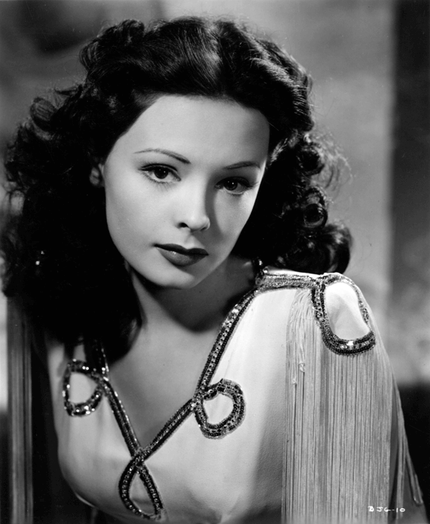
Jane Greer was an American actress born on September 9, 1924, in Washington, D.C. She is best known for her work in film noir during the 1940s and 1950s. With her sultry beauty, smoky voice, and captivating presence, Greer became one of the iconic femme fatales of the genre.
Greer began her career as a model and caught the attention of a talent scout while appearing in a Life magazine advertisement. She signed a contract with RKO Pictures in 1943 and made her film debut in the musical comedy "Two O'Clock Courage" (1945). However, it was her role as the manipulative and alluring femme fatale Kathie Moffat in the film "Out of the Past" (1947) that solidified her reputation as a prominent figure in film noir.
"Out of the Past" is considered one of the quintessential film noirs, and Greer's portrayal of Kathie Moffat opposite Robert Mitchum garnered critical acclaim. Her performance was praised for its complexity, as she brought a seductive and dangerous quality to the character. Greer's chemistry with Mitchum and her ability to convey both vulnerability and deceit made her a memorable femme fatale and established her as a sought-after actress in the genre.
Following the success of "Out of the Past," Greer continued to excel in film noir and other dramatic roles. Some of her notable film noir appearances include "They Won't Believe Me" (1947), "The Big Steal" (1949), and "Station West" (1948). Greer often portrayed femme fatales or women entangled in dangerous situations, utilizing her alluring presence and natural talent for creating a sense of mystery and intrigue.
In addition to her film noir roles, Greer also appeared in other genres, including Westerns and dramas. She showcased her versatility as an actress in films like "Run for the Sun" (1956) and "The Prisoner of Zenda" (1952). Despite her talent and success, Greer's career didn't reach the same heights as some of her contemporaries, partially due to contractual disputes and a brief hiatus from acting.
Greer continued to work in film and television throughout the 1950s and 1960s, but her career gradually declined. She made occasional appearances in later years, including a notable role in David Lynch's "Twin Peaks: Fire Walk with Me" (1992), which brought her back into the spotlight. Despite her relatively short period of active film work, Greer left a lasting impact on the film noir genre with her captivating performances and memorable femme fatale portrayals.
Jane Greer passed away on August 24, 2001, in Los Angeles, California, leaving behind a legacy as one of the iconic actresses of film noir. Her contributions to the genre continue to be celebrated, and her performances remain an integral part of the classic film noir canon.
Greer began her career as a model and caught the attention of a talent scout while appearing in a Life magazine advertisement. She signed a contract with RKO Pictures in 1943 and made her film debut in the musical comedy "Two O'Clock Courage" (1945). However, it was her role as the manipulative and alluring femme fatale Kathie Moffat in the film "Out of the Past" (1947) that solidified her reputation as a prominent figure in film noir.
"Out of the Past" is considered one of the quintessential film noirs, and Greer's portrayal of Kathie Moffat opposite Robert Mitchum garnered critical acclaim. Her performance was praised for its complexity, as she brought a seductive and dangerous quality to the character. Greer's chemistry with Mitchum and her ability to convey both vulnerability and deceit made her a memorable femme fatale and established her as a sought-after actress in the genre.
Following the success of "Out of the Past," Greer continued to excel in film noir and other dramatic roles. Some of her notable film noir appearances include "They Won't Believe Me" (1947), "The Big Steal" (1949), and "Station West" (1948). Greer often portrayed femme fatales or women entangled in dangerous situations, utilizing her alluring presence and natural talent for creating a sense of mystery and intrigue.
In addition to her film noir roles, Greer also appeared in other genres, including Westerns and dramas. She showcased her versatility as an actress in films like "Run for the Sun" (1956) and "The Prisoner of Zenda" (1952). Despite her talent and success, Greer's career didn't reach the same heights as some of her contemporaries, partially due to contractual disputes and a brief hiatus from acting.
Greer continued to work in film and television throughout the 1950s and 1960s, but her career gradually declined. She made occasional appearances in later years, including a notable role in David Lynch's "Twin Peaks: Fire Walk with Me" (1992), which brought her back into the spotlight. Despite her relatively short period of active film work, Greer left a lasting impact on the film noir genre with her captivating performances and memorable femme fatale portrayals.
Jane Greer passed away on August 24, 2001, in Los Angeles, California, leaving behind a legacy as one of the iconic actresses of film noir. Her contributions to the genre continue to be celebrated, and her performances remain an integral part of the classic film noir canon.
quotes:
"I'd always wanted to be an actress, and suddenly I knew that learning to control my facial muscles was one of the best assets I could have as a performer. Emotions often must be portrayed from an inner feeling, of course, but I had a double advantage because I was learning to direct my as-yet expressionless feelings, as well as gaining an ability to express emotion by a very conscious manipulation of my muscles."
"Howard Hughes was obsessed with me. But at first it seemed as if he were offering me a superb career opportunity."
"I love making movies, but I was ready to rationalize being only a mother if my career never got back on track."
[asked about her memories of making Station West (1948)] "Dick Powell was very nice, but the director, who shall remain nameless [Sidney Lanfield], was a real son-of-a-bitch. He was terrible to me--in fact, terrible to any woman. Can you imagine, this guy says to Agnes Moorehead, "Do you think when you say a line, hatchet-face?". She came back with, "I've taken enough. The boat just sailed and you're on it". She refused to work with him, so another director had to do her remaining scenes. As for me, I was a basket case--in tears! He'd say something ugly to me just before I started a scene. I was glaring and had tears, and he'd ask what was the matter with me! Finally, when we were back from location in Arizona, he was told, "It's either you or her, and we have her under contract". After that, I wasn't touched by him . . . I got to know [Raymond Burr] quite well at RKO. Because of everything that happened, he had to coach me for "Station West". I certainly received no help from that director."
- Jane Greer
trivia:
Often portrayed jilted lovers, bad girls, unfaithful wives, and women with a past. | Was supposed to play the female lead in the film noir classic The Killers (1946) with Burt Lancaster but filming Lady in the Lake (1946) became too long and involved so she couldn't do the part. Instead MGM took a chance on Ava Gardner in the role and, of course, she became a star.
During her bachelorette days she was courted by such actors as Brian Donlevy, Ted North, Lew Ayres, Robert Walker, David Niven, and Cary Grant. | Director George Stevens originally sought Totter for the role of Alice Tripp for his film A Place in the Sun (1951) but MGM refused to loan her out. The part was later secured by Shelley Winters.
Following her high school graduation, she worked as a radio actress in New York City, New York, and Chicago, Illinois, prior to her moving to Hollywood, California during the middle of World War II to establish herself in motion pictures.
She was given advice at MGM by Lionel Barrymore, "You're one of the best actresses I've ever seen, but you're never going to be a star. You're too versatile. If you want to be a star, start projecting your own personality."
Appeared with Robert Montgomery in two movies, Lady in the Lake (1946) and The Saxon Charm (1948).
During her bachelorette days she was courted by such actors as Brian Donlevy, Ted North, Lew Ayres, Robert Walker, David Niven, and Cary Grant. | Director George Stevens originally sought Totter for the role of Alice Tripp for his film A Place in the Sun (1951) but MGM refused to loan her out. The part was later secured by Shelley Winters.
Following her high school graduation, she worked as a radio actress in New York City, New York, and Chicago, Illinois, prior to her moving to Hollywood, California during the middle of World War II to establish herself in motion pictures.
She was given advice at MGM by Lionel Barrymore, "You're one of the best actresses I've ever seen, but you're never going to be a star. You're too versatile. If you want to be a star, start projecting your own personality."
Appeared with Robert Montgomery in two movies, Lady in the Lake (1946) and The Saxon Charm (1948).

